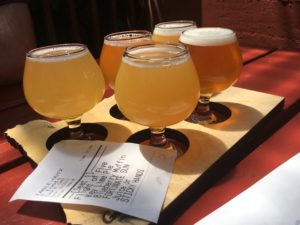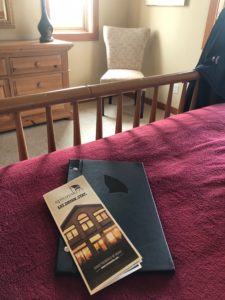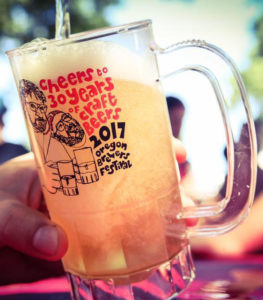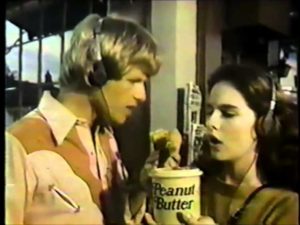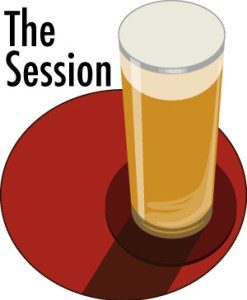 The jet lag may still be lingering, but getting back to London is always worth it. While much has changed since I first moved there in the 1990s - most notably, that everything is so clean, which was absolutely not a feature of so-called Britpop London - it was lovely to see some of my old stomping grounds in a new (visible) light. It's probably fair to say that I drank 'reasonable,' albeit cheap, beer as a postgrad/early career adult back in the day; lots of pints of Directors at my local Wetherspoons, but there wasn't much beyond that, at least so far as I was aware.
The jet lag may still be lingering, but getting back to London is always worth it. While much has changed since I first moved there in the 1990s - most notably, that everything is so clean, which was absolutely not a feature of so-called Britpop London - it was lovely to see some of my old stomping grounds in a new (visible) light. It's probably fair to say that I drank 'reasonable,' albeit cheap, beer as a postgrad/early career adult back in the day; lots of pints of Directors at my local Wetherspoons, but there wasn't much beyond that, at least so far as I was aware.
Fast forward to the present day, to a (I have to say it again, very clean) London where specialist beer bars and small breweries abound, and there is so much choice that it requires some navigation; for that, we relied on Des De Moor's excellent guidebook, plus regular last-minute Twitter ideas from Melissa Cole and Pete Brown (though we never did make it to his Stoke Newington ‘hood - I looked at a cheap bedsit there nearly two decades ago and would love to go back to see it now, though I'm sure I'd lament not having had the wherewithal to buy some portion of it then, when I had £25/week to spend on rent - I ended up getting something for the same amount in East Ham instead, which had the distinction of being near The Who Shop, though little else - but I digress). We upped the degree of difficulty by having our kids in tow, and while our older one claims he could easily pass for 16 (and he's probably right), finding a place with great beer that is also reasonably welcoming to a 3-year-old is a trickier challenge.
With that in mind, we were thrilled to have great experiences at The Rake, CASK Pub & Kitchen and The Craft Beer Co. Covent Garden. Each one had a fantastic lineup of CASK ALE (I miss real handpumps so much) and a variety of interesting kegged options. They also had friendly, deeply knowledgeable staff and a largely non-bro-y clientele, which was very pleasant indeed. We found traditional pubs a bit more hit and miss (though I'm mindful that we were often firmly in Tourist London, which can veer toward the more generic), but thoroughly enjoyed The George - re-reading Pete Brown's book on the plane was useful - and The Lamb, which was an occasional hangout spot of mine as a student; visiting as an adult with children was a very different experience, as its proximity to Coram's Fields was a major selling point in ensuring a less-fussy meal - and I had one of my best beers of the trip there.
With that segue, I'll again call out the range of cask beer on offer, essentially everywhere we went, which is absolutely not an expectation in Seattle (though I wish it were - it was much more readily accessible in Philadelphia, but there you go). Particular standouts included the aforementioned beer at The Lamb – Jack Brand Mosaic Pale Ale from Adnams was one of the best pale ales I've had in recent memory, and certainly the best cask pale ale I enjoyed. And as it's a Young's house, the Winter Warmer was firmly on the agenda, and as lovely as I remember it. Another favo(u)rite was Barnsley Bitter from Stancill Brewery, which is exactly the sort of beer I wish I had as a regular go-to; it was very nearly perfect. Moving to the dark side, Glamorgan Brewing Co's Welsh Cake Stout was delightful, as was Truman’s Brewery's Original Porter - finally, a good porter! Also of note was a black IPA from Windsor & Eton, Conqueror; ironically, the style seems to have vanished from our home in Cascadia, so it was very pleasing to find a well-crafted, hoppy/dark beer elsewhere. We had two historical beers from The Kernel, and while both were very fine, the edge went to their Export Stout London 1890, which was absolutely fantastic though the Imperial Brown Stout London 1856 was also excellent.
Obviously we did some non-drink-related things too - you may have heard of a can-do little musical called Hamilton, and I have nothing but praise for the talented London cast - and the Harry Potter exhibit at the British Library is well worth a visit. We also made some discoveries and rediscoveries. I've long been a Foyles partisan, but we didn't have a chance to make it to their (still new to me) headquarters. We made up for that omission by taking over Daunt Books and buying up as much of their stock as we could carry (including Boak & Bailey's 20th Century Pub, at long last). Persephone Books made themselves more even more dangerous by ensuring we left with a catalogue, and I enthusiastically recommend the London Transport Museum. While I've been there before alone, there is no better place to take an alternately happy, clingy, angry and curious jet-lagged toddler, and the current exhibit on women artists is spectacular. The kids get to touch, climb and play while adults enjoy the exhibits, and everyone comes out happy (if lighter in the bank account). They also had quite reasonable tea, though the dearth of good tea in London may need to be its own post - why did so many otherwise-good hotels, restaurants and pubs want to foist their Twinings supermarket tea upon us? I realize we may not be the target tourist market, in that there is really great tea everywhere you go in the Pacific Northwest and so we expect it, but it did seem odd that we had to seek out teas we'd normally consider passable, rather than really good. If any venture capitalists are looking for a new vertical, let's get top-quality fair trade tea to become A Thing - only the museum cafes delivered.
Finally, I'll recommend two very different experiences: the London Mithraeum, well-preserved and well-presented underneath the new Bloomberg building, may be one of the best public archaeology installations I've seen. I won't say that no expense has been spared, as I'm sure there's been some sort of trade-off, but it's really very impressive, and should serve as some sort of model for other developers. And as it's only a temporary happening, you should make your way soonish to the Southbank Centre for ABBA: Super Troopers: The Exhibition. If you've ever wondered what an immersive ABBA-themed experience, narrated by the dulcet northern tones of Jarvis Cocker, would be like, wonder no more. It is utterly delightful (and my 12 year old will vouch for this as well).
Out of the many places I've lived, London and New York are still my favorites - hardly surprising for a city-obsessed theatre nerd, but London does edge out New York when it comes to beer; I wish I had more excuses to get back to both more often (ideally, of course, on someone else's dime, but who wouldn't want that?). All outrageous job offers happily considered!
